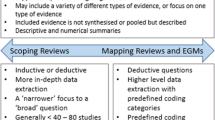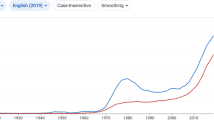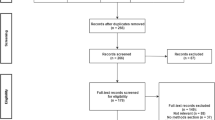Abstract
As detailed in Marshall et al. (Quinn Marshall, Jessica Fanzo, Christopher B. Barrett, Andrew D. Jones, Anna Herforth, and Rebecca McLaren, “Building a global food systems typology: A new tool for reducing complexity in food systems analysis,” Frontiers in Sustainable Food Systems, vol. 5 (November 2021): 746512), the food systems typologies we and the Food Systems Dashboard use were developed using a method that began with a structured scoping review of the existing food systems literature.
You have full access to this open access chapter, Download chapter PDF
Similar content being viewed by others
Food Systems Typologies
These details are adapted from Marshall et al. (2021), which provides considerably more detail on the method, its validation, and application.
As detailed in Marshall et al. (2021), the food systems typologies we and the Food Systems Dashboard use were developed using a method that began with a structured scoping review of the existing food systems literature. Based on the variables found in that review, a parsimonious set of four variables was identified from which to build the typology using simple quantitative methods. The variables were selected according to the following criteria: (1) the group of indicators chosen should reflect different components of the food system; (2) the literature should support the indicators’ association with food system patterns and transitions; and (3) indicators should have high global coverage, including across different regions and income group classifications.
The four component indicators are: agricultural value-added per worker; the percent of dietary energy from cereals, roots, and tubers (i.e., staple foods); the number of supermarkets per 100,000 inhabitants; and urban population as a percent of total population. The underlying data were sourced from the World Bank, FAO, Food Balance Sheets, and Euromonitor. We include 155 countries for which data was available for all four indicators.
For each indicator, countries were ranked from highest to lowest, under the hypothesis that higher values were associated with more “modern” food systems, and lower values with more “traditional” food systems. The ranking was inverted in the case of the share of dietary energy from cereals, roots, and tubers, which is theorized to decrease as food systems grow more advanced.
Each country was assigned a score equal to the sum of its ranks on each of the four indicators. For example, if a country ranked tenth on agricultural value-added; fifteenth on share of dietary energy from cereals, roots, and tubers; seventeenth on number of supermarkets per 100,000 population; and eighth on urbanization, its score was 50. After calculating scores for each country, we sorted countries from lowest to highest score and divided them into quintiles. The lowest quintile represents the most modern AFS type and the highest the most traditional system type. Cross-system patterns in the four underlying variables used to create the typology align with narratives provided by the food systems, nutrition transition, and structural transformation literatures, exhibiting statistically significant variation among groups even though substantial heterogeneity still exists within individual food system types.
Country classifications based on this method were then validated against a host of other food systems–related indicators that were not used to construct the rankings and the typologies. We found that the typology, indeed, generates sensible patterns in a broad suite of diet, nutrition, health, socioeconomic, and environmental outcomes across the resulting food system types.
Innovations’ Impacts on SDGs
These details are adapted from Herrero et al. (2021), which provides considerably more detail on the methods used for data generation and analysis, as well as additional explanation of the these and other specific innovations analyzed.
Herrero et al. (2020, 2021) collated an inventory of future technologies that could accelerate progress towards achieving the food systems–related SDGs. To assemble the inventory of possible technologies, they carried out literature searches around the idea of AFS transformation. The literature searches were complemented by researcher expert opinions. They found approximately 80 technologies that directly addressed some dimension of the food system. These were classified into the following technology groups: cellular agriculture, digital agriculture, food processing and safety, gene technology, inputs, intensification, replacement food and feed, and others.
The key criteria for inclusion in the inventory were that (1) technologies needed to have a direct impact on the key processes associated with the food system from production to consumption, and (2) they represented “products” of some type that were applicable to the food system. The inventory contains some groupings of very similar technologies for which it would be difficult to separate the magnitudes and types of their impacts. Many management and system-level interventions, as well as technologies from other sectors, will undoubtedly also play critical roles in improving food systems, but these are not specifically covered here (Herrero et al. 2020).
Herrero et al. (2020) classified each technology by its Technology Readiness Index and elicited expected qualitative assessments of its potential impacts and likelihood of adoption to 2030 (to align with the SDG time horizon) using an online ranking tool to evaluate and score each of the technologies with respect to three characteristics. The potential impact of the technology on the SDGs is of particular relevance to this report. The most directly AFS-relevant SDGs for which technology’s potential impact was directly elicited were the following:
-
SDG 1: End poverty in all its forms everywhere
-
SDG 2: End hunger, achieve food security and improved nutrition, and promote sustainable agriculture
-
SDG 3: Ensure healthy lives and promote well-being for all at all ages
-
SDG 6: Ensure availability and sustainable management of water and sanitation for all
-
SDG 12: Ensure sustainable consumption and production patterns
-
SDG 13: Take urgent action to combat climate change and its impacts
-
SDG 14: Conserve and sustainably use the oceans, seas, and marine resources for sustainable development
-
SDG 15: Protect, restore, and promote sustainable use of terrestrial ecosystems, sustainably manage forests, combat desertification, halt and reverse land degradation, and halt biodiversity loss.
The potential impacts were scored using a 7-point score as follows:
-
3: A large positive impact
-
2: A moderate positive impact
-
1: A small positive impact
-
0: A neutral (neither positive nor negative) impact
-
−1: A small negative impact.
-
−2: A moderate negative impact
-
−3: A large negative impact
The survey was completed by 32 experienced respondents, all authors of Herrero et al. (2020). Respondents were asked to score only those technologies for which they felt comfortable providing an opinion. Descriptive statistics were then calculated for each technology and the results analyzed statistically. For more details, see Herrero et al. (2020, 2021).
References
Herrero, Mario, Philip K. Thornton, Daniel Mason-D’Croz, Jeda Palmer, Tim G. Benton, Benjamin L. Bodirsky, Jessica R. Bogard, et al. 2020. Innovation can accelerate the transition towards a sustainable food system. Nature Food 1 (5): 266–272. https://doi.org/10.1038/s43016-020-0074-1.
Herrero, Mario, Philip K. Thornton, Daniel Mason-D’Croz, J. Palmer, B. L. Bodirsky, P. Pradhan, C. B. Barrett, T. G. Benton, et al. 2021. Articulating the impact of food systems innovation on the Sustainable Development Goals. The Lancet Planetary Health 5 (1): e50–e62. https://doi.org/10.1016/S2542-5196(20)30277-1.
Marshall, Quinn, Jessica Fanzo, Christopher B. Barrett, Andrew D. Jones, Anna Herforth, and Rebecca McLaren. 2021. Building a global food systems typology: A new tool for reducing complexity in food systems analysis. Frontiers in Sustainable Food Systems 5: 432. https://doi.org/10.3389/fsufs.2021.746512.
Author information
Authors and Affiliations
Corresponding author
Rights and permissions
Open Access This chapter is licensed under the terms of the Creative Commons Attribution 4.0 International License (http://creativecommons.org/licenses/by/4.0/), which permits use, sharing, adaptation, distribution and reproduction in any medium or format, as long as you give appropriate credit to the original author(s) and the source, provide a link to the Creative Commons license and indicate if changes were made.
The images or other third party material in this chapter are included in the chapter's Creative Commons license, unless indicated otherwise in a credit line to the material. If material is not included in the chapter's Creative Commons license and your intended use is not permitted by statutory regulation or exceeds the permitted use, you will need to obtain permission directly from the copyright holder.
Copyright information
© 2022 The Author(s)
About this chapter
Cite this chapter
Barrett, C.B. et al. (2022). Technical Appendix. In: Socio-Technical Innovation Bundles for Agri-Food Systems Transformation. Sustainable Development Goals Series. Palgrave Macmillan, Cham. https://doi.org/10.1007/978-3-030-88802-2_10
Download citation
DOI: https://doi.org/10.1007/978-3-030-88802-2_10
Published:
Publisher Name: Palgrave Macmillan, Cham
Print ISBN: 978-3-030-88801-5
Online ISBN: 978-3-030-88802-2
eBook Packages: Economics and FinanceEconomics and Finance (R0)




